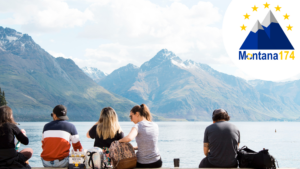Article 174 of the Treaty on the Functioning of the European Union recognizes “a particular attention” to mountainous areas and encourages dedicated measures for these territories via the European Cohesion Policy. This article reflects on the impacts of the 2014-2020 Cohesion Policy on mountain areas, and it introduces its opportunities over the 2021-2027 programming period.

Cohesion Policy: a special attention to mountains
The Cohesion Policy is the European Union’s largest investment policy and one of the most fundamentals policies of the Union. Almost a third of the total budget of the European Union (EU) have been set aside for the Cohesion Policy over time, with slight variations across the different programming periods. Over the 2021-2027 period, its portfolio equals to 30.8% of EU budget (€392 billion), compared to 33.9% over the 2014-2020 period.
The budget of the Cohesion Policy is of utmost importance for those EU regions that lag behind – in socio-economic terms – as it allows to invest on fundamental services, such as access to job and employment, boosting mobility, improving quality education, as well as to finance innovation and green transition. Mountain areas across Europe belong to this category as they have to face several challenges – from depopulation to ageing, climate change, lack of basic services – with often limited human and financial capital. The resources of the Cohesion Policy can contribute to address some of these barriers and leverage place-based assets. This has been acknowledged by the European legislators that, through Article 174 of the European Treaty of the Functioning of the EU, stated that a “particular attention” should be paid to mountainous areas, as they suffer “severe and permanent natural or demographic handicaps” that hinder their development.
The benefits of the Cohesion Policy for mountain communities
As evidenced by the new Kohesio platform and by Montana174 brochures of good practices, the Cohesion Policy financed several key projects to improve quality of life across Europe’s mountains, from the Alps to Pyrenees, Carpathians and Northern mountains. For instance between 2014 and 2019, in the Greek mountains, a huge investment was made to bring the broadband connection to 5,077 villages and 525,287 residents in mountainous regions and other marginal areas, about 45% of Greek territory. Another example is a car sharing project in the French-Swiss Jura mountains, that since 2015 promote alternatives to single-person cars for workers. Up to 2021, about 180 enterprises and 41,000 adhered to their system, leading to an average annual saving of 1,100 kg of C02 and €2,300 per worker.
Additionally, some Cohesion Policy’s programmes have been tailored to the needs of mountain areas. For instance, the Interreg Alpine Space financed activities in the Alps, or the Interreg POCTEFA, that invested in the Pyrenees.
Similarly, many cross-border, transnational and interregional programmes, as well as national and regional Managing Authorities provided resources designated to mountain areas, even though in some cases they have not made a specific reference to these territories in their Operational Programmes (OP). An exceptional case for the 2014-2020 period, have been the emergence of “inter-massif Operational Programmes” in France, specifically dedicated to address the needs mountainous areas. This was a French peculiarity that has evolved into “interregional chapters” over the 2021-2027 period.
Opportunities for mountain areas until 2027
Over the 2021-2027 period, the Cohesion Policy continues to invest in mountains, with additional resources from the Next Generation EU programme. The Policy Objective 5 has been specifically designed to finance activities “closer to citizens” and hence responding to place-based needs, such as the ones of mountain areas. However, it is fundamental to highlight that more important financial resources are channelled via the other four Policy Objectives and can be equally used to finance relevant projects in these territories. For instance, under the Policy Objective 1 “Smarter Europe”, the European Commission supports the roll-out of the Smart Villages concept, that triggers social and digital innovation in rural and mountainous settings.
Another remarkable example is the support to climate action. Approximately 30% of the ERDF, 37% of the Cohesion Fund and 100% of the Just Transition Fund shall be devoted to achieving climate-related targets between 2021 and 2027. To this end, programmes such as Interreg the Bavaria-Czech Operational Programme will invest in measures to make forest more resilient to climate and invest in disaster management actions to limit the impacts of extreme weather events and natural disaster in mountainous areas.
The emergence of new Small-Scale Partnership under the Interreg programmes is another novelty of the current Cohesion Policy. With a more limited budget, partners and shorter duration, these projects are an opportunity for less-experienced organisations, such as many mountain stakeholders, to be involved as they require less administrative burden and less specific skills. Moreover, some regional and national Operational Programmes will channel these funds via specific measures, such as “interregional chapters” for mountainous areas in France, or via the Strategies of Inner Areas in Italy. Their implementation shall be followed and assessed closely, to give rise to some reflections on their effectiveness and eventually scaling up.
From facts to action
Even though some Operational Programmes for the 2021-2027 period are still under negotiations, the ones already approved can support concrete actions in mountains. But how much of these resources is actually absorbed by mountain actors? As emerged by Montana174 project, most often mountain actors are unaware of the opportunities driven by the Cohesion Policy. To solve this, better communication on existing opportunities to mountain actors, as well as one-stop-shops to facilitate the understanding of the different funds and more capacity-building opportunities on how to access these funds would be highly welcomed. Additionally, a dedicated European study with a high granularity of analysis (NUTS-3 or NUTS-4 level) on the absorption of Cohesion Policy funds and barriers to it would be particularly valuable. It would provide a more completed picture on the impacts of the Cohesion Policy on mountain territories at large, as well as on their effectiveness to produce cohesion.
This subject was at the centre of Montana174 final conference “How to foster the effective uptake of Cohesion Policy funds in mountain areas?”, on 20th September 2022 in Brussels, Belgium.

Maria Carla Lostrangio is a Project Manager for Euromontana. Euromontana is the European multisectoral association for co-operation and development of mountain territories. It embraces regional and national mountain organisations throughout greater Europe, including regional development agencies, local authorities, agriculture organisations, environmental agencies, forestry organisations and research institutes.
Are you currently involved with regional research, policy, and development? The Regional Studies Association is accepting articles for their online blog. For more information, contact the Blog Editor at rsablog@regionalstudies.org.